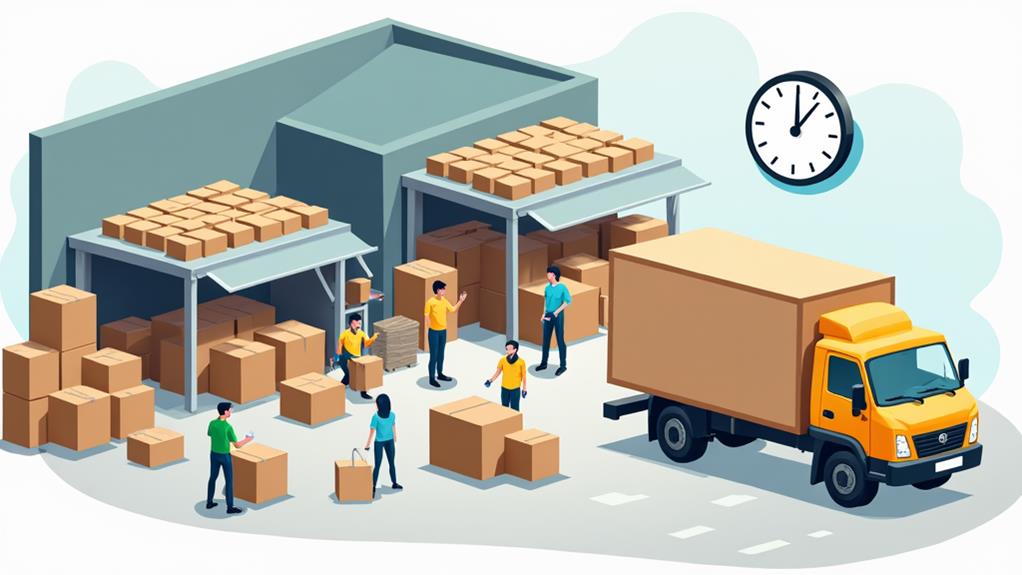
Guaranteeing timely delivery in print on demand involves a blend of strategic order fulfillment, efficient shipping methods, and data-driven inventory management. Implement automated systems to streamline picking, packing, and shipping processes, enhancing accuracy and speed. Evaluate delivery options—standard, express, and economy—to meet diverse customer preferences cost-effectively. Implement flat rate or free shipping strategies to simplify pricing and encourage larger orders. Continual analysis of carrier rates and inventory trends guarantees optimized operations. Effective communication of shipping deadlines and real-time order tracking are pivotal to maintaining customer trust and satisfaction. Further insights can optimize your fulfillment strategy.
Key Takeaways
- Implement automated systems and data analytics to streamline order fulfillment and enhance inventory management.
- Negotiate with suppliers and choose cost-effective carriers to balance delivery speed and cost for timely shipments.
- Offer tiered shipping rates to encourage larger orders and provide cost savings for customers.
- Utilize seasonal shipping strategies to capture urgent buyers with Express Shipping and attract cost-conscious consumers post-holiday.
- Regularly review and adjust shipping methods and pricing strategies based on customer feedback and market trends.
Understanding Order Fulfillment
Order fulfillment is an all-encompassing process that spans from the moment an order is placed until it reaches the customer's hands, involving critical steps such as inventory management, picking, packing, and shipping.
In the domain of e-commerce, efficient order fulfillment is paramount, enhancing brand credibility and customer trust. However, the path to seamless order processing is fraught with fulfillment challenges. Rising consumer expectations, driven by industry giants like Amazon, place significant pressure on businesses to deliver quickly and accurately. Clear communication of shipping timelines and product information further reduces confusion and dissatisfaction.
Managing the order fulfillment process can be approached in two primary ways: in-house management or outsourcing to third-party logistics (3PL) providers. Each method has its strategic advantages, contingent upon the business's size and sales volume. Smaller businesses might find in-house management more feasible, while larger enterprises could benefit from the scalability offered by 3PL providers.
Leveraging automated systems and data analytics emerges as a key strategy to mitigate fulfillment challenges. These technologies reduce errors, streamline operations, and enhance inventory management, leading to greater efficiency.
Monitoring key metrics such as order accuracy, fulfillment time, and shipping costs is essential for continuous improvement. By strategically addressing these facets, businesses can navigate the complexities of order processing and achieve superior fulfillment outcomes.
Shipping Pricing Strategies
In examining shipping pricing strategies, it is essential to balance the benefits of offering free shipping, which can enhance conversion rates, with the risk of profit margin erosion, particularly for international orders.
For sustainable growth, building strong supplier relationships guarantees that shipping costs can be negotiated effectively, offering better terms and pricing.
Flat rate shipping, on the other hand, provides a straightforward customer experience but requires meticulous analysis of average shipping costs to guarantee sustainability.
Both strategies necessitate a careful assessment of customer expectations, market standards, and potential impacts on profitability.
Free Shipping Benefits
Free shipping stands as a powerful lever in the arsenal of shipping pricing strategies, presenting considerable benefits that can drive a business's success. From a shipping psychology perspective, offering free shipping can greatly enhance product attractiveness, addressing common pain points related to shipping costs and increasing conversion rates.
This strategic move not only improves customer retention by fostering loyalty but also encourages higher average order values, as customers are more likely to add additional items to their cart to qualify for free shipping thresholds.
However, implementing free shipping requires a delicate balance between cost management and competitive pricing. Integrating shipping costs into product pricing or establishing minimum order values are common tactics that allow businesses to offer free shipping without eroding profit margins.
This approach guarantees competitiveness while managing expenses effectively. An effective free shipping strategy should also be dynamic, taking into account seasonal trends and customer expectations.
Flat Rate Shipping
One effective approach to shipping pricing strategies is flat rate shipping, which simplifies the customer experience by offering a consistent shipping fee irrespective of order size or weight. This method enhances transparency and predictability, positively influencing customer perception. To establish a sustainable flat rate, businesses must analyze average shipping costs, ensuring the fixed rate covers expenses while remaining attractive.
Implementing flat rate shipping can encourage larger purchases, as customers often seek to maximize value from the fixed fee. Furthermore, a strategically calculated flat rate helps businesses compete against those offering free or discounted shipping options.
Regular review and adjustment of flat rates, based on shipping cost fluctuations and customer feedback, are essential for maintaining effectiveness and customer satisfaction. This proactive approach dispels common shipping myths regarding the inflexibility of flat rates and demonstrates a commitment to adapting to market dynamics.
| Benefit | Impact on Customers |
|---|---|
| Simplified Experience | Enhanced Transparency |
| Encourages Larger Orders | Increased Order Value |
| Competitive Edge | Improved Market Position |
| Regular Adjustments | Sustained Satisfaction |
Understanding and leveraging flat rate shipping can notably improve customer perception, ensuring a seamless and satisfactory delivery experience.
Offering Free Shipping
Effective strategies in the print-on-demand market often hinge on the allure of free shipping, a powerful driver of customer conversion and loyalty. Offering free shipping can provide a competitive advantage, notably enhancing the attractiveness of products. This strategic move can lead to increased conversion rates and foster customer retention, vital for driving repeat purchases in a competitive landscape.
To maintain profit margins while offering free shipping, businesses often raise product prices or set minimum order values. This guarantees that the shipping cost does not excessively erode profits. Studies indicate that approximately 93% of consumers consider free shipping a key factor in their purchasing decisions. This statistic underscores the potential impact of free shipping on sales performance.
Furthermore, free shipping can encourage customers to increase their order value. Many consumers are willing to add more items to their carts to qualify for the offer, thereby optimizing the average order value.
However, it is essential to conduct a thorough analysis of shipping costs and customer expectations. This analysis helps determine the most sustainable approach, making sure that free shipping remains a feasible option without leading to potential financial losses.
Choosing Shipping Methods
When selecting shipping methods for Print on Demand, it is essential to balance delivery speed and cost to meet diverse customer preferences.
Evaluating options like express, standard, and economy shipping, along with analyzing carrier rates and reliability, enables businesses to offer competitive and flexible solutions.
Additionally, considering tiered shipping rates can strategically encourage larger orders by offering cost savings for customers.
Integrating with dropshipping apps can streamline order management, improving efficiency and consistency in shipping and fulfillment processes.
Evaluating Shipping Speeds
In the domain of Print on Demand (POD) businesses, evaluating shipping speeds necessitates a strategic approach to selecting the appropriate shipping methods. Understanding and leveraging Shipping Innovations can considerably improve delivery outcomes and meet diverse Delivery Expectations.
POD businesses typically offer a range of shipping options—Economy, Standard, Express, and Priority—each designed to cater to varying customer needs and preferences.
Economy Shipping, starting at a cost-effective $3.99, generally delivers within 4-8 business days and is ideal for price-sensitive customers seeking affordability. Conversely, Express Shipping, beginning at $7.99, appeals to over 60% of shoppers who prioritize faster delivery, often within 1-3 business days.
During peak seasons, promoting Express Shipping can capture urgent buyers, whereas shifting to Economy Shipping post-holiday can attract cost-conscious consumers.
Seasonal adjustments in shipping methods are essential for aligning with fluctuating customer demands. The right carrier selection and shipping method choice not only influence delivery speeds but also impact overall profitability and customer satisfaction.
Therefore, evaluating and strategically implementing varied shipping speeds guarantees POD businesses can adeptly balance cost efficiency with the imperative of meeting or exceeding customer delivery expectations.
Cost-Effective Carrier Selection
Selecting the right shipping carrier is a critical decision that requires a detailed analysis of multiple factors, including delivery speed, reliability, and cost. A strategic approach involves utilizing real-time carrier rate comparisons to identify the most cost-effective options, guaranteeing a prime balance between affordability and timely delivery. Leveraging local carrier advantages can be particularly beneficial for regional deliveries, often resulting in lower shipping costs due to reduced travel distances.
Carrier selection should also account for shipping zones and distances, as these greatly influence costs. Additionally, implementing tiered shipping rates can incentivize larger purchases by reducing per-item shipping costs. For international shipments, it is essential to factor in additional customs fees and taxes, and clearly communicate these to customers to maintain transparency and trust.
| Carrier Type | Advantages |
|---|---|
| Local Carriers | Lower costs for regional deliveries |
| National Carriers | Consistent service across the country |
| International Carriers | Capable of handling customs and taxes |
| Negotiated Rates | Reduced costs through partnerships |
Engaging in carrier rate negotiations can further reduce expenses, enhancing overall cost-efficiency. By meticulously evaluating these elements, businesses can guarantee superior customer satisfaction and streamlined fulfillment processes.
Implementing Flat Rate Shipping

Implementing flat rate shipping can greatly streamline the purchasing process for print-on-demand businesses by offering a consistent and predictable shipping cost, regardless of order size or weight. This approach not only simplifies the shipping cost analysis but also aligns with customer satisfaction strategies by reducing cart abandonment rates.
Customers appreciate knowing the exact shipping costs upfront, which enhances their overall shopping experience and builds trust. Additionally, integrating performance analysis tools to monitor shipping efficiency can optimize your strategy further by providing insights into delivery times and customer satisfaction.
To establish a sustainable flat rate, it is vital to analyze average shipping costs meticulously. This guarantees the rate covers all expenses while remaining attractive to price-sensitive customers. Effective flat rate shipping allows for easier budgeting and forecasting, accommodating the varying order volumes typical of print-on-demand businesses.
By providing financial predictability, businesses can strategically price their products to remain competitive. Moreover, implementing flat rate shipping enhances transparency, an essential factor in fostering customer loyalty.
When customers trust that there are no hidden fees, their satisfaction increases, leading to repeat purchases. Additionally, offering tiered flat rate options can incentivize larger orders, reducing the shipping cost per item and boosting the average order value.
Utilizing Tiered Shipping Rates
Utilizing tiered shipping rates presents a strategic opportunity for print-on-demand businesses to drive higher order values while catering to diverse customer needs. By setting specific shipping thresholds, such as offering free shipping for orders over $50, businesses can effectively use customer incentives to encourage larger purchases. This strategy not only increases average order value but also fosters customer loyalty.
Furthermore, assessing product relevance to your audience can further enhance the effectiveness of your shipping strategies, guaranteeing that promotions align with customer interests.
To effectively implement tiered shipping rates, consider the following:
- Set Clear Shipping Thresholds: Determine ideal thresholds where customers receive benefits, such as reduced or free shipping, for higher order values.
- Analyze Shipping Costs: Conduct a thorough analysis of average shipping costs to guarantee the tiered rates remain profitable without alienating potential customers.
- Communicate Benefits: Clearly communicate the advantages of spending more to your customers, highlighting the savings they can achieve through tiered shipping.
- Monitor and Adjust: Continuously monitor the performance of your tiered shipping strategy and be prepared to adjust thresholds and incentives to maintain competitiveness.
Implementing tiered shipping rates can enhance customer satisfaction by providing flexible options that align with diverse purchasing behaviors. Additionally, this approach can reduce the overall cost per item shipped, making it a cost-effective strategy for maximizing shipping expenses.
Seasonal Shipping Strategies

Seasonal shipping strategies, such as promoting Express Shipping during the holiday season, are essential for capturing last-minute shoppers and meeting their urgent delivery needs.
Implementing high-quality packaging materials prevents product damage during transit, ensuring that even expedited orders arrive intact.
Adjusting delivery timelines post-holiday to highlight Economy Shipping options can appeal to cost-conscious consumers, fostering customer loyalty during slower sales periods.
Implementing these tactics, alongside analyzing seasonal demand trends, allows businesses to optimize inventory and fulfillment processes, ensuring timely delivery and high customer satisfaction.
Holiday Shipping Promotions
Holiday shipping promotions play a vital role in enhancing customer engagement and boosting sales during peak shopping seasons. Understanding holiday order trends and customer shipping preferences is important for formulating effective promotional strategies.
Here are four key approaches to maximize the impact of your holiday shipping promotions:
- Free Shipping Offers: Implementing free shipping for orders over a certain value can greatly drive sales. This strategy not only appeals to budget-conscious consumers but also encourages larger purchases.
- Express Shipping Options: With over 60% of shoppers prioritizing fast delivery, especially for last-minute gifts, offering express shipping options can be a game-changer. Making sure these options are prominently displayed can enhance customer satisfaction.
- Clear Communication of Shipping Deadlines: Communicating shipping cut-off dates clearly is essential to manage customer expectations and guarantee timely delivery. Tailoring these deadlines based on location and carrier nuances can mitigate disappointment and build trust.
- Data-Driven Inventory Management: Analyzing previous holiday sales data helps anticipate demand spikes, enabling businesses to adjust inventory and fulfillment strategies. This proactive approach minimizes stockouts and delivery delays, assuring a smooth holiday shopping experience.
Adjusting Delivery Timelines
Adapting delivery timelines to align with seasonal demand is an essential strategy for optimizing fulfillment efficiency and customer satisfaction. Implementing seasonal adjustments, such as promoting Express Shipping during holiday periods, targets last-minute buyers and boosts sales through timely deliveries. This strategic approach not only meets delivery expectations but also captures additional revenue opportunities.
Adjusting fulfillment timelines based on seasonal demand is significant to guarantee that inventory levels align with customer purchasing patterns. This alignment reduces stockouts and optimizes order processing, thereby enhancing overall fulfillment efficiency.
Moreover, clear communication regarding potential delays during peak seasons, such as increased fulfillment times due to high order volumes, is important. This transparency helps manage customer expectations and strengthens satisfaction.
Utilizing real-time tracking systems during busy seasons is another key strategy. It allows customers to stay informed about their order status, reducing inquiries and building trust in the fulfillment process.
Additionally, offering tiered shipping options that incentivize larger purchases during seasonal sales can help maintain profitability while appealing to cost-sensitive customers. These extensive seasonal adjustments not only streamline operations but also guarantee that delivery expectations are met, fostering a positive customer experience.
Enhancing Customer Satisfaction
To enhance customer satisfaction in the print-on-demand industry, implementing strategic shipping and fulfillment practices is vital. Customer feedback and satisfaction metrics play a significant role in shaping these strategies, ensuring that businesses meet and exceed customer expectations.
1. Offer Free Shipping: Studies indicate that 93% of online shoppers are more likely to complete a purchase when free shipping is available. This not only drives sales but also markedly boosts customer satisfaction.
Similar to how pet sitters can increase bookings by offering additional services, free shipping can be a strategic advantage in the print-on-demand industry.
2. Automated Updates: Keeping customers informed with automated updates throughout the fulfillment process reduces inquiries and enhances satisfaction. Transparency in order status builds trust and diminishes anxiety related to delivery timelines.
3. Tiered Shipping Rates: Implementing tiered shipping rates encourages larger purchases, thereby increasing average order value. This approach not only drives revenue but also fosters customer loyalty through perceived value and improved satisfaction.
4. Clear Return Policy: A concise and understandable return policy is essential. With 67% of shoppers considering return policies before purchasing, clarity in this area enhances customer trust and overall satisfaction.
Additionally, ensuring quality control and utilizing branded packaging enrich the unboxing experience, contributing positively to the brand's perception.
Managing Shipping Delays

While enhancing customer satisfaction through strategic shipping and fulfillment practices is paramount, addressing shipping delays requires a different set of tactical measures. Effective delay management starts with clear customer communication. By setting accurate shipping expectations upfront, particularly for custom or made-to-order items, businesses can mitigate customer dissatisfaction. Proactive notifications about potential delays, especially during peak seasons or due to international customs, are essential to maintain fulfillment transparency.
Implementing systems that provide timely shipping updates is vital. These updates not only keep customers informed about their order status but also foster customer trust. For example, informing customers about production delays or high order volumes allows them to adjust their expectations accordingly.
Regularly analyzing fulfillment metrics and historical data can help identify patterns, enabling businesses to anticipate delays and communicate proactively. Additionally, personalized services tailored to each customer's unique needs can further enhance client satisfaction despite potential delays.
Moreover, consistent and transparent communication throughout the fulfillment process reassures customers that their orders are being managed diligently. By integrating these strategic measures, companies can enhance their delay management capabilities, ensuring that customers remain informed and satisfied despite potential shipping setbacks.
Ultimately, the goal is to maintain a transparent, informed, and trust-driven relationship with customers.
Real-Time Order Tracking
By harnessing the power of real-time order tracking, businesses can greatly enhance transparency and customer satisfaction. Implementing robust tracking systems allows customers to receive instant updates on their order status, markedly reducing inquiries about shipment progress. This integration with major shipping carriers guarantees extensive tracking capabilities, enabling customers to monitor their packages from fulfillment to delivery.
Additionally, offering multiple payment options can further streamline the purchasing process and improve overall customer experience.
To maximize the benefits of real-time order tracking, consider these strategic points:
- Order Visibility: Providing tracking links in order confirmation emails keeps customers informed and engaged, improving overall satisfaction.
- Accurate Forecasting: Utilizing data analytics within tracking systems to forecast shipping times based on historical performance helps businesses set realistic delivery expectations.
- Proactive Communication: Informing customers about any delays through real-time updates fosters trust and loyalty, essential for strengthening customer relationships and encouraging repeat purchases.
- Enhanced Customer Engagement: Continuous updates and transparent communication throughout the shipping process boost customer engagement, guaranteeing they feel valued and informed.
Ultimately, integrating real-time order tracking is not just a logistical enhancement but a strategic move to build customer trust and loyalty. By maintaining high order visibility and proactive communication, businesses can create a seamless and engaging customer experience, vital for long-term success in the print on demand industry.
Optimizing Inventory Management

Effective inventory management is vital for success in the print on demand (POD) industry, as it hinges on leveraging real-time tracking systems to maintain precise stock levels. Implementing such systems prevents overselling and stockouts, thereby guaranteeing timely order fulfillment.
Utilizing data analytics for demand forecasting further enables businesses to optimize reorder points, reducing the risk of overstocking while assuring product availability in alignment with sales trends.
Strategically, businesses should deploy Warehouse Management Systems (WMS) to streamline inventory storage and order processing. This enhances operational efficiency and greatly reduces fulfillment times.
Integrating barcode scanning technology automates inventory tracking throughout the supply chain, minimizing errors and improving overall accuracy in order fulfillment.
Regular evaluation of inventory turnover rates is fundamental. By identifying slow-moving products, businesses can take timely actions such as promotions or discontinuations to optimize stock levels.
Such measures not only improve fulfillment efficiency but also contribute to better stock optimization. Fundamentally, a well-managed inventory system in the POD industry guarantees a seamless balance between supply and demand, thereby facilitating timely and efficient order delivery.
Leveraging Data for Decisions
In the competitive landscape of the print on demand (POD) industry, leveraging data for decision-making is vital for enhancing operational efficiency and customer satisfaction.
Data driven decisions and predictive analytics play an important role in refining various aspects of shipping and fulfillment.
- Inventory Turnover Rates: By analyzing data on inventory turnover rates, businesses can improve demand forecasting and maintain ideal stock levels. This guarantees the prevention of stockouts and overstock situations, thereby balancing supply with market demand.
- Real-Time Tracking Systems: Utilizing real-time tracking systems increases the visibility of shipping processes. This allows businesses to provide precise shipping timelines and promptly communicate any delays to customers, thereby enhancing transparency and trust.
- Seasonal Trends Analysis: Analyzing historical sales data reveals seasonal trends. This enables businesses to adjust their fulfillment strategies in anticipation of peak demand periods, guaranteeing readiness and efficiency during high-volume times.
- Automated Reporting Tools: Implementing automated reporting tools streamlines the monitoring of key fulfillment metrics, such as order accuracy and fulfillment time.
Continuous improvement is facilitated through timely insights and responsive adjustments.
Frequently Asked Questions
How Can I Speed up My Order Fulfillment?
To expedite order fulfillment, optimize inventory management through data analytics to maintain stock levels and implement automated order processing. Establish strategic shipping partnerships offering multiple delivery options and use real-time tracking to enhance customer satisfaction.
How to Effectively Manage the Order Fulfillment Processing?
To effectively manage order fulfillment processing, implement robust inventory management for real-time stock monitoring and utilize advanced order tracking systems. This guarantees accurate, timely processing, reduces errors, and enhances overall operational efficiency and customer satisfaction.
Which of These Are Strategies to Speed up Your Order Fulfillment Process?
To expedite order fulfillment, implement real-time inventory management to prevent stockouts, utilize automation for streamlined workflows, employ efficient packing practices, leverage local fulfillment centers, and maintain strong supplier relationships to guarantee timely resupply and delivery.
What Is Print on Demand Fulfillment?
Print on demand fulfillment is a process where products are produced only after an order is placed, ensuring no inventory storage. Key factors include print quality and supplier reliability, impacting overall efficiency and customer satisfaction.
Conclusion
Ensuring timely delivery in print on demand involves a multifaceted strategy encompassing effective order fulfillment, strategic shipping pricing, and the judicious selection of shipping methods. Key components include offering free shipping, implementing flat rate options, managing delays proactively, and providing real-time order tracking. Additionally, optimizing inventory management and leveraging data-driven decisions are critical. These elements collectively enhance operational efficiency and customer satisfaction, thereby fostering a competitive advantage in the market.
Leave a Reply